Optimization of 3D Extrusion Printing Parameters for Raw and Extruded Dehulled Andean Fava Bean Flours Using Response Surface Methodology (RSM)
Abstract
1. Introduction
2. Materials and Methods
2.1. Production and Characterization of Dehulled Andean Fava Bean Flours
2.2. Experimental Design
2.3. 3D Printing
2.4. Quality Evaluation of 3DFP Products
2.4.1. Surface Color Distribution
2.4.2. Printing Accuracy
2.4.3. Surface Texture of the Print
2.4.4. Instrumental Texture Profile
2.5. Statistical Analysis
3. Results
3.1. Physicochemical and Techno-Functional Characteristics of Raw and Extruded Andean Fava Bean Flours
3.2. Quality of 3DFP Products
3.2.1. Quality of Samples Printed with Raw Fava Bean Flour (RFB)
3.2.2. Quality of Samples Printed with Extruded Fava Bean Flour (EFB)
3.3. Optimization of Printing Parameters
4. Conclusions
Supplementary Materials
Author Contributions
Funding
Institutional Review Board Statement
Informed Consent Statement
Data Availability Statement
Conflicts of Interest
References
- Rogers, H.; Srivastava, M. Emerging Sustainable Supply Chain Models for 3D Food Printing. Sustainability 2021, 13, 12085. [Google Scholar] [CrossRef]
- Guan, H.; Sun, Y.; Liu, X.; Zhang, Z. Research Progress of 3D Printing Technology in Animal-Derived Food Processing. Food Ferment. Ind. 2024, 50, 325–333. [Google Scholar] [CrossRef]
- Donn, P.; Prieto, M.A.; Mejuto, J.C.; Cao, H.; Simal-Gandara, J. Functional Foods Based on the Recovery of Bioactive Ingredients from Food and Algae By-Products by Emerging Extraction Technologies and 3D Printing. Food Biosci. 2022, 49, 101853. [Google Scholar] [CrossRef]
- Čukelj Mustač, N.; Pastor, K.; Kojić, J.; Voučko, B.; Ćurić, D.; Rocha, J.M.; Novotni, D. Quality Assessment of 3D-Printed Cereal-Based Products. LWT 2023, 184, 115065. [Google Scholar] [CrossRef]
- Besnea, D.; Avram, M.; Cananau, S.; Moraru, E.; Spanu, A.; Constantin, V.; Panait, I.C. Constructive and Functional Particularities of 3D Printers with Applications in the Food Industry. In Proceedings of the IOP Conference Series: Materials Science and Engineering, Sozopol, Bulgaria, 10–13 September 2020; Volume 997. [Google Scholar]
- Padhiary, M.; Barbhuiya, J.A.; Roy, D.; Roy, P. 3D Printing Applications in Smart Farming and Food Processing. Smart Agric. Technol. 2024, 9, 100553. [Google Scholar] [CrossRef]
- Mudau, M.; Adebo, O.A. Three Dimensional (3D)-printed Foods: A Review of Recent Advances in Their Ingredients, Printing Techniques, Food Printers, Post-processing Methods, Consumer Acceptance and Safety. J. Food Process Eng. 2024, 47, e14621. [Google Scholar] [CrossRef]
- Thorakkattu, P.; Awasti, N.; Sajith Babu, K.; Khanashyam, A.C.; Deliephan, A.; Shah, K.; Singh, P.; Pandiselvam, R.; Nirmal, N.P. 3D Printing: Trends and Approaches toward Achieving Long-Term Sustainability in the Food Industry. Crit. Rev. Biotechnol. 2025, 45, 48–68. [Google Scholar] [CrossRef]
- Dancausa Millán, M.G.; Millán Vázquez de la Torre, M.G. 3D Food Printing: Technological Advances, Personalization and Future Challenges in the Food Industry. Int. J. Gastron. Food Sci. 2024, 37, 100963. [Google Scholar] [CrossRef]
- Ulrikh, E.V.; Verkhoturov, V.V. Features of Food Design on a 3d Printer. A Review. Pis. Sist. Food Syst. 2022, 5, 100–106. [Google Scholar] [CrossRef]
- Raja, V.; Moses, J.A.; Anandharamakrishnan, C. Effect of 3D Printing Conditions and Post-Printing Fermentation on Pearl Millet Fortified Idli. J. Sci. Food Agric. 2023, 103, 2401–2412. [Google Scholar] [CrossRef]
- Guénard-Lampron, V.; Liu, X.; Masson, M.; Blumenthal, D. Screening of Different Flours for 3D Food Printing: Optimization of Thermomechanical Process of Soy and Rye Flour Dough. Innov. Food Sci. Emerg. Technol. 2023, 87, 103394. [Google Scholar] [CrossRef]
- Guan, C.; Long, X.; Long, Z.; Lin, Q.; Liu, C. Legumes Flour: A Review of the Nutritional Properties, Physiological Functions and Application in Extruded Rice Products. Int. J. Food Sci. Technol. 2023, 58, 300–314. [Google Scholar] [CrossRef]
- Zheng, L.; Liu, J.; Liu, R.; Xing, Y.; Jiang, H. 3D Printing Performance of Gels from Wheat Starch, Flour and Whole Meal. Food Chem. 2021, 356, 129546. [Google Scholar] [CrossRef]
- Salvador-Reyes, R.; Furlan, L.C.; Martínez-Villaluenga, C.; Dala-Paula, B.M.; Clerici, M.T.P.S. From Ancient Crop to Modern Superfood: Exploring the History, Diversity, Characteristics, Technological Applications, and Culinary Uses of Peruvian Fava Beans. Food Res. Int. 2023, 173, 113394. [Google Scholar] [CrossRef] [PubMed]
- Salvador-Reyes, R.; Furlan, L.C.; Martínez-Villaluenga, C.; Martins Dala-Paula, B.; Harumi Nabeshima, E.; da Costa Pinto, C.; Michielon de Souza, S.; Azevedo Lima Pallone, J.; Teresa Pedrosa Silva Clerici, M. Peruvian Fava Beans for Health and Food Innovation: Physicochemical, Morphological, Nutritional, and Techno-Functional Characterization. Food Res. Int. 2024, 192, 114814. [Google Scholar] [CrossRef] [PubMed]
- Mayer Labba, I.C.; Frøkiær, H.; Sandberg, A.S. Nutritional and Antinutritional Composition of Fava Bean (Vicia Faba L., Var. Minor) Cultivars. Food Res. Int. 2021, 140, 110038. [Google Scholar] [CrossRef] [PubMed]
- Salvador-Reyes, R.; Teresa Pedrosa Silva Clerici, M.; Martínez-Villaluenga, C. Enhancing the Nutritional and Bioactive Benefits of Faba Bean Flour by Combining Preprocessing and Thermoplastic Extrusion: A Comprehensive Study on Digestion-Resistant Peptides. Food Res. Int. 2024, 183, 114231. [Google Scholar] [CrossRef]
- Huma, N.; Anjum, F.M.; Sehar, S.; Issa Khan, M.; Hussain, S. Effect of Soaking and Cooking on Nutritional Quality and Safety of Legumes. Nutr. Food Sci. 2008, 38, 570–577. [Google Scholar] [CrossRef]
- Siah, S.; Wood, J.A.; Agboola, S.; Konczak, I.; Blanchard, C.L. Effects of Soaking, Boiling and Autoclaving on the Phenolic Contents and Antioxidant Activities of Faba Beans (Vicia Faba L.) Differing in Seed Coat Colours. Food Chem. 2014, 142, 461–468. [Google Scholar] [CrossRef]
- El-Hady, E.A.A.; Habiba, R.A. Effect of Soaking and Extrusion Conditions on Antinutrients and Protein Digestibility of Legume Seeds. LWT Food Sci. Technol. 2003, 36, 285–293. [Google Scholar] [CrossRef]
- Shi, L.; Arntfield, S.D.; Nickerson, M. Changes in Levels of Phytic Acid, Lectins and Oxalates during Soaking and Cooking of Canadian Pulses. Food Res. Int. 2018, 107, 660–668. [Google Scholar] [CrossRef]
- Shi, D.; Stone, A.K.; Marinangeli, C.P.F.; Carlin, J.; Nickerson, M.T. Faba bean nutrition: Macronutrients, antinutrients, and the effect of processing. Cereal Chem. 2024, 101, 1181–1197. [Google Scholar] [CrossRef]
- Patterson, C.A.; Curran, J.; Der, T. Effect of Processing on Antinutrient Compounds in Pulses. Cereal Chem. 2017, 94, 2–10. [Google Scholar] [CrossRef]
- Popova, A.; Mihaylova, D. Antinutrients in Plant-Based Foods: A Review. Open Biotechnol. J. 2019, 13, 68–76. [Google Scholar] [CrossRef]
- Brennan, M.A.; Monro, J.A.; Brennan, C.S. Effect of Inclusion of Soluble and Insoluble Fibres into Extruded Breakfast Cereal Products Made with Reverse Screw Configuration. Int. J. Food Sci. Technol. 2008, 43, 2278–2288. [Google Scholar] [CrossRef]
- Liu, Y.; Chen, K.; Zeng, Q.; Wang, P.; Zhang, Y. The Impact of Dietary Fibers on the Construction and Molecular Network of Extrusion-Based 3D-Printed Chicken Noodles: Unlocking the Potential of Specialized Functional Food. Food Chem. 2025, 463, 141065. [Google Scholar] [CrossRef] [PubMed]
- Singh, S.; Gamlath, S.; Wakeling, L. Nutritional Aspects of Food Extrusion: A Review. Int. J. Food Sci. Technol. 2007, 42, 916–929. [Google Scholar] [CrossRef]
- Ek, P.; Ganjyal, G.M. Basics of extrusion processing. In Extrusion Cooking; Ganjyal, G.M., Ed.; Woodhead Publishing: New Delhi, Delhi, 2020; pp. 1–28. [Google Scholar] [CrossRef]
- Ek, P.; Kowalski, R.J.; Ganjyal, G.M. Raw material behaviors in extrusion processing I (Carbohydrates). In Extrusion Cooking; Ganjyal, G.M., Ed.; Woodhead Publishing: New Delhi, Delhi, 2020; pp. 119–152. [Google Scholar] [CrossRef]
- Alam, M.S.; Kaur, J.; Khaira, H.; Gupta, K. Extrusion and Extruded Products: Changes in Quality Attributes as Affected by Extrusion Process Parameters: A Review. Crit. Rev. Food Sci. Nutr. 2016, 56, 445–473. [Google Scholar] [CrossRef] [PubMed]
- Espinosa-Ramírez, J.; Rodríguez, A.; De la Rosa-Millán, J.; Heredia-Olea, E.; Pérez-Carrillo, E.; Serna-Saldívar, S.O. Shear-Induced Enhancement of Technofunctional Properties of Whole Grain Flours through Extrusion. Food Hydrocoll. 2021, 111, 106400. [Google Scholar] [CrossRef]
- Comettant-Rabanal, R.; Carvalho, C.W.P.; Ascheri, J.L.R.; Chávez, D.W.H.; Germani, R. Extruded Whole Grain Flours and Sprout Millet as Functional Ingredients for Gluten-Free Bread. LWT 2021, 150, 112042. [Google Scholar] [CrossRef]
- Kaur, G.; Sharma, S.; Singh, B.; Dar, B.N. Comparative Study on Functional, Rheological, Thermal, and Morphological Properties of Native and Modified Cereal Flours. Int. J. Food Prop. 2016, 19, 1949–1961. [Google Scholar] [CrossRef]
- Martínez, M.M.; Rosell, C.M.; Gómez, M. Modification of Wheat Flour Functionality and Digestibility through Different Extrusion Conditions. J. Food Eng. 2014, 143, 74–79. [Google Scholar] [CrossRef]
- Lille, M.; Kortekangas, A.; Heiniö, R.-L.; Sozer, N. Structural and Textural Characteristics of 3D-Printed Protein- and Dietary Fibre-Rich Snacks Made of Milk Powder and Wholegrain Rye Flour. Foods 2020, 9, 1527. [Google Scholar] [CrossRef] [PubMed]
- Krishnaraj, P.; Anukiruthika, T.; Choudhary, P.; Moses, J.A.; Anandharamakrishnan, C. 3D Extrusion Printing and Post-Processing of Fibre-Rich Snack from Indigenous Composite Flour. Food Bioproc. Technol. 2019, 12, 1776–1786. [Google Scholar] [CrossRef]
- Wang, M.; Li, D.; Zang, Z.; Sun, X.; Tan, H.; Si, X.; Tian, J.; Teng, W.; Wang, J.; Liang, Q.; et al. 3D Food Printing: Applications of Plant-Based Materials in Extrusion-Based Food Printing. Crit. Rev. Food Sci. Nutr. 2021, 62, 7184–7198. [Google Scholar] [CrossRef] [PubMed]
- Masbernat, L.; Berland, S.; Leverrier, C.; Moulin, G.; Michon, C.; Almeida, G. Structuring Wheat Dough Using a Thermomechanical Process, from Liquid Food to 3D-Printable Food Material. J. Food Eng. 2021, 310, 110696. [Google Scholar] [CrossRef]
- Başoğlu, E.İ.; Özgeçen, A.B.; Yavuz, N. Enhancement of 3D-Printability of Zucchini Puree by Rice Flour Addition. Int. J. Food Sci. Technol. 2024, 59, 8181–8190. [Google Scholar] [CrossRef]
- Thangalakshmi, S.; Arora, V.K.; Prithviraj, V. Printability Assessment and Optimization of Process Parameters for 3D Printing of Rice Flour and Jaggery Paste. J. Biosyst. Eng. 2022, 47, 248–262. [Google Scholar] [CrossRef]
- Barrios-Rodríguez, Y.F.; Igual, M.; Martínez-Monzó, J.; García-Segovia, P. Multivariate Evaluation of the Printing Process on 3D Printing of Rice Protein. Food Res. Int. 2024, 176, 113838. [Google Scholar] [CrossRef]
- Liu, L.; Yang, X.; Bhandari, B.; Meng, Y.; Prakash, S. Optimization of the Formulation and Properties of 3D-Printed Complex Egg White Protein Objects. Foods 2020, 9, 164. [Google Scholar] [CrossRef] [PubMed]
- Zhang, Y.; Lee, A.Y.; Pojchanun, K.; Lee, C.P.; Zhou, A.; An, J.; Hashimoto, M.; Tan, U.-X.; Leo, C.H.; Wong, G.; et al. Systematic Engineering Approach for Optimization of Multi-Component Alternative Protein-Fortified 3D Printing Food Ink. Food Hydrocoll. 2022, 131, 107803. [Google Scholar] [CrossRef]
- Su, A.; He, A.; Ma, G.; Zhao, L.; Yang, W.; Hu, Q. Modeling and Optimization of 3D Printing Process of Pleurotus Eryngii Powder Using Neural Network-Genetic Algorithm. Sci. Agric. Sin. 2024, 57, 584–596. [Google Scholar] [CrossRef]
- Xia, G.; Tao, L.; Zhang, S.; Hao, X.; Ou, S. An Optimization Study of 3D Printing Technology Utilizing a Hybrid Gel System Based on Astragalus Polysaccharide and Wheat Starch. Processes 2024, 12, 1898. [Google Scholar] [CrossRef]
- Lee, C.P.; Hashimoto, M. Prediction of Textural Properties of 3D-Printed Food Using Response Surface Methodology. Heliyon 2024, 10, e27658. [Google Scholar] [CrossRef] [PubMed]
- Diañez, I.; Gallegos, C.; Brito-de la Fuente, E.; Martínez, I.; Valencia, C.; Sánchez, M.C.; Diaz, M.J.; Franco, J.M. 3D Printing in Situ Gelification of κ-Carrageenan Solutions: Effect of Printing Variables on the Rheological Response. Food Hydrocoll. 2019, 87, 321–330. [Google Scholar] [CrossRef]
- Alonso, R.; Aguirre, A.; Marzo, F. Effects of Extrusion and Traditional Processing Methods on Antinutrients and in Vitro Digestibility of Protein and Starch in Faba and Kidney Beans. Food Chem. 2000, 68, 159–165. [Google Scholar] [CrossRef]
- Sahni, P.; Sharma, S. Influence of Processing Treatments on Cooking Quality, Functional Properties, Antinutrients, Bioactive Potential and Mineral Profile of Alfalfa. LWT 2020, 132, 109890. [Google Scholar] [CrossRef]
- Das, G.; Sharma, A.; Sarkar, P.K. Conventional and Emerging Processing Techniques for the Post-Harvest Reduction of Antinutrients in Edible Legumes. Appl. Food Res. 2022, 2, 100112. [Google Scholar] [CrossRef]
- American Association of Cereal Chemists. Approved Methods of the American Association of Cereal Chemists; AACC: St. Paul, MN, USA, 2000. [Google Scholar]
- Anderson, R.A.; Conway, H.F.; Peplinski, A.J. Gelatinization of Corn Grits by Roll Cooking, Extrusion Cooking and Steaming. Starch-Stärke 1970, 22, 130–135. [Google Scholar] [CrossRef]
- Lemus-Mondaca, R.; Puente-Díaz, L.; Vásquez-Montaño, A.; León, E.; Zura-Bravo, L.; Ortiz-Viedma, J. Printability and Thermophysical Properties of Three-Dimensional-Printed Food Based on “Cochayuyo” Durvillaea Antarctica Seaweed Flour. Foods 2024, 13, 1825. [Google Scholar] [CrossRef]
- Liu, Y.; Tang, T.; Duan, S.; Qin, Z.; Li, C.; Zhang, Z.; Liu, A.; Wu, D.; Chen, H.; Han, G.; et al. Effects of Sodium Alginate and Rice Variety on the Physicochemical Characteristics and 3D Printing Feasibility of Rice Paste. LWT 2020, 127, 109360. [Google Scholar] [CrossRef]
- Berrios, J.D.J.; Morales, P.; Cámara, M.; Sánchez-Mata, M.C. Carbohydrate Composition of Raw and Extruded Pulse Flours. Food Res. Int. 2010, 43, 531–536. [Google Scholar] [CrossRef]
- Li, X.; Manickavasagan, A.; Lim, L.-T. Reduction of Antinutrients and Off-Flavour in Kidney Bean Flour by Acidic and Alkaline Reactive Extrusion. Food Res. Int. 2024, 192, 114832. [Google Scholar] [CrossRef] [PubMed]
- Naumann, S.; Schweiggert-Weisz, U.; Martin, A.; Schuster, M.; Eisner, P. Effects of Extrusion Processing on the Physiochemical and Functional Properties of Lupin Kernel Fibre. Food Hydrocoll. 2021, 111, 106222. [Google Scholar] [CrossRef]
- Arshad, R.; Saqib, A.; Sharif, H.R.; Liaqat, A.; Xu, B. Recent Advances in 3D Food Printing: Therapeutic Implications, Opportunities, Potential Applications, and Challenges in the Food Industry. Food Res. Int. 2025, 203, 115791. [Google Scholar] [CrossRef]
- Zhuang, J.; Zhu, J.; Cheung, P.C.K.; Li, C. The Physical and Chemical Interactions between Starch and Dietary Fiber: Their Impact on the Physicochemical and Nutritional Properties of Starch. Trends Food Sci. Technol. 2024, 149, 104566. [Google Scholar] [CrossRef]
- Rocha-Guzman, N.E.; Gallegos-Infante, J.A.; Gonzalez-Laredo, R.F.; Bello-Perez, A.; Delgado-Licon, E.; Ochoa-Martinez, A.; Prado-Ortiz, M.J. Physical Properties of Extruded Products from Three Mexican Common Beans (Phaseolus Vulgaris L.) Cultivars. Plant Foods Hum. Nutr. 2008, 63, 99–104. [Google Scholar] [CrossRef] [PubMed]
- Agarwal, D.; Wallace, A.; Kim, E.H.J.; Wadamori, Y.; Feng, L.; Hedderley, D.; Morgenstern, M.P. Rheological, Structural and Textural Characteristics of 3D-Printed and Conventionally-Produced Gluten-Free Snack Made with Chickpea and Lupin Flour. Future Foods 2022, 5, 100134. [Google Scholar] [CrossRef]
- Chen, J.; Sun, H.; Mu, T.; Blecker, C.; Richel, A.; Richard, G.; Jacquet, N.; Haubruge, E.; Goffin, D. Effect of Temperature on Rheological, Structural, and Textural Properties of Soy Protein Isolate Pastes for 3D Food Printing. J. Food Eng. 2022, 323, 110917. [Google Scholar] [CrossRef]
- Liu, Z.; Zhang, M.; Bhandari, B.; Yang, C. Impact of Rheological Properties of Mashed Potatoes on 3D Printing. J. Food Eng. 2018, 220, 76–82. [Google Scholar] [CrossRef]
- Zhu, S.; Stieger, M.A.; van der Goot, A.J.; Schutyser, M.A.I. Extrusion-Based 3D Printing of Food Pastes: Correlating Rheological Properties with Printing Behaviour. Innov. Food Sci. Emerg. Technol. 2019, 58, 102214. [Google Scholar] [CrossRef]
- Siacor, F.D.C.; Chen, Q.; Zhao, J.Y.; Han, L.; Valino, A.D.; Taboada, E.B.; Caldona, E.B.; Advincula, R.C. On the Additive Manufacturing (3D Printing) of Viscoelastic Materials and Flow Behavior: From Composites to Food Manufacturing. Addit. Manuf. 2021, 45, 102043. [Google Scholar] [CrossRef]
- Gholamipour-Shirazi, A.; Norton, I.T.; Mills, T. Designing Hydrocolloid Based Food-Ink Formulations for Extrusion 3D Printing. Food Hydrocoll. 2019, 95, 161–167. [Google Scholar] [CrossRef]
- Sui, X.; Meng, Z.; Dong, T.; Fan, X.; Wang, Q. Enzymatic Browning and Polyphenol Oxidase Control Strategies. Curr. Opin. Biotechnol. 2023, 81, 102921. [Google Scholar] [CrossRef] [PubMed]
- Salvador-Reyes, R.; Paucar-Menacho, L.M. Optimization of the Blanching Time and Temperature in the Manufacture of Hass Avocado Pulp Using Low Quality Discarded Fruits. Braz. J. Food Technol. 2019, 22, e2018244. [Google Scholar] [CrossRef]
- Michalczyk, D.J.; Krupka, M.; Kamiński, J.; Wierzbicka, M.; Floryańska, S.; Kopeć, W.; Piotrowicz-Cieślak, A.I. Physiological and Biochemical Parameters of Field Bean (Vicia faba Var. minor) Seeds Stored for 33 Years. Agriculture 2023, 13, 2012. [Google Scholar] [CrossRef]
- Nogales-Delgado, S. Polyphenoloxidase (Ppo): Effect, Current Determination and Inhibition Treatments in Fresh-Cut Produce. Appl. Sci. 2021, 11, 7813. [Google Scholar] [CrossRef]
- Liu, Z.; Zhang, M.; Bhandari, B.; Wang, Y. 3D Printing: Printing Precision and Application in Food Sector. Trends Food Sci Technol. 2017, 69, 83–94. [Google Scholar] [CrossRef]
- Zhang, L.; Lou, Y.; Schutyser, M.A.I. 3D Printing of Cereal-Based Food Structures Containing Probiotics. Food Struct. 2018, 18, 14–22. [Google Scholar] [CrossRef]
- Godoi, F.C.; Prakash, S.; Bhandari, B.R. 3d Printing Technologies Applied for Food Design: Status and Prospects. J. Food Eng. 2016, 179, 44–54. [Google Scholar] [CrossRef]
- Sun, J.; Zhou, W.; Huang, D.; Fuh, J.Y.H.; Hong, G.S. An Overview of 3D Printing Technologies for Food Fabrication. Food Bioproc. Tech. 2015, 8, 1605–1615. [Google Scholar] [CrossRef]
- Yang, F.; Zhang, M.; Fang, Z.; Liu, Y. Impact of Processing Parameters and Post-Treatment on the Shape Accuracy of 3D-Printed Baking Dough. Int. J. Food Sci. Technol. 2019, 54, 68–74. [Google Scholar] [CrossRef]
- Derossi, A.; Paolillo, M.; Caporizzi, R.; Severini, C. Extending the 3D Food Printing Tests at High Speed. Material Deposition and Effect of Non-Printing Movements on the Final Quality of Printed Structures. J. Food Eng. 2020, 275, 109865. [Google Scholar] [CrossRef]
- Haralick, R.M.; Dinstein, I.; Shanmugam, K. Textural Features for Image Classification. In IEEE Transactions on Systems, Man, and Cybernetics; IEEE: Piscataway, NJ, USA, 1973; Volume SMC-3. [Google Scholar] [CrossRef]
- Baigts-Allende, D.; Ramírez-Rodrígues, M.; Rosas-Romero, R. Monitoring of the Dehydration Process of Apple Snacks with Visual Feature Extraction and Image Processing Techniques. Appl. Sci. 2022, 12, 11269. [Google Scholar] [CrossRef]
- Davidovic, L.M.; Cumic, J.; Dugalic, S.; Vicentic, S.; Sevarac, Z.; Petroianu, G.; Corridon, P.; Pantic, I. Gray-Level Co-Occurrence Matrix Analysis for the Detection of Discrete, Ethanol-Induced, Structural Changes in Cell Nuclei: An Artificial Intelligence Approach. Microsc. Microanal. 2021, 28, 265–271. [Google Scholar] [CrossRef]
- Kristianto, Y.; Wignyanto, W.; Argo, B.D.; Santoso, I. Changes of Gray Level Co-Occurrence Matrix (GLCM) Texture and Antioxidant Level during Freezing of Pumpkin. In Proceedings of the IOP Conference Series: Earth and Environmental Science, Banda Aceh, Indonesia (Virtual), 21 September 2021; Volume 733. [Google Scholar]
- van Rompay, T.J.L.; Finger, F.; Saakes, D.; Fenko, A. “See Me, Feel Me”: Effects of 3D-Printed Surface Patterns on Beverage Evaluation. Food Qual. Prefer 2017, 62, 332–339. [Google Scholar] [CrossRef]
- van Rompay, T.; van Ooijen, I.; Groothedde, S.; Saakes, D. (Not to Be Taken) with a Grain of Salt: Enhancing Perceived Saltiness by 3D-Printed Surface Textures. Food Qual. Prefer 2021, 93, 104279. [Google Scholar] [CrossRef]
- Parmar, P.; Bobade, H.; Singh, B.; Pathania, S. Extrusion Technologies for Cereal-Pulses Blends. In Pulse Foods: Processing, Quality and Nutraceutical Applications; Academic Press: Cambridge, MA, USA, 2020. [Google Scholar]
- Kathuria, D.; Hamid; Gautam, S.; Thakur, A. Maillard Reaction in Different Food Products: Effect on Product Quality, Human Health and Mitigation Strategies. Food Control 2023, 153, 109911. [Google Scholar] [CrossRef]
- Chakraborty, P.; Eqbal, M.D.; Ahmed, J. Three-Dimensional Printing and Its Application to Legume Proteins: A Review. Legume Sci. 2023, 5, e172. [Google Scholar] [CrossRef]
- Liu, Z.; Bhandari, B.; Zhang, M. Incorporation of Probiotics (Bifidobacterium Animalis Subsp. Lactis) into 3D Printed Mashed Potatoes: Effects of Variables on the Viability. Food Res. Int. 2019, 128, 108795. [Google Scholar] [CrossRef]
- Prithviraj, V.; Thangalakshmi, S.; Arora, V.K.; Liu, Z. Characterization of Rice Flour and Pastes with Different Sweeteners for Extrusion-Based 3D Food Printing. J. Texture Stud. 2022, 53, 895–907. [Google Scholar] [CrossRef] [PubMed]
- In, J.; Jeong, H.; Min, S.C. Material Requirements for Printing Cookie Dough Using a Fused Deposition Modeling 3D Printer. Food Sci. Biotechnol. 2022, 31, 807–817. [Google Scholar] [CrossRef] [PubMed]
- Huang, M.s; Zhang, M.; Bhandari, B. Assessing the 3D Printing Precision and Texture Properties of Brown Rice Induced by Infill Levels and Printing Variables. Food Bioproc. Technol. 2019, 12, 1185–1196. [Google Scholar] [CrossRef]
- Téllez-Morales, J.A.; Herman-Lara, E.; Gómez-Aldapa, C.A.; Rodríguez-Miranda, J. Techno-Functional Properties of the Starch-Protein Interaction during Extrusion-Cooking of a Model System (Corn Starch and Whey Protein Isolate). LWT 2020, 132, 109789. [Google Scholar] [CrossRef]
- Zhang, H.; Meng, Y.; Liu, X.; Guan, X.; Huang, K.; Li, S. Effect of Extruded Mung Bean Flour on Dough Rheology and Quality of Chinese Noodles. Cereal Chem. 2019, 96, 836–846. [Google Scholar] [CrossRef]
- Mohamed, I.O. Interaction of Starch with Some Food Macromolecules during the Extrusion Process and Its Effect on Modulating Physicochemical and Digestible Properties. A Review. Carbohydr. Polym. Technol. Appl. 2023, 5, 100294. [Google Scholar] [CrossRef]
- Shi, M.; Dong, X.; Cheng, Y.; Ji, X.; Liu, Y.; Yan, Y. Preparation and Characterization of Extruded Yam Starch–Soy Protein Isolate Complexes and Their Effects on the Quality of Dough. Foods 2023, 12, 360. [Google Scholar] [CrossRef] [PubMed]
- Ma, Y.; Schutyser, M.A.I.; Boom, R.M.; Zhang, L. Thermographic and Rheological Characterization of Viscoelastic Materials for Hot-Extrusion 3D Food Printing. Innov. Food Sci. Emerg. Technol. 2022, 81, 103135. [Google Scholar] [CrossRef]
- Liu, Z.; Bhandari, B.; Prakash, S.; Mantihal, S.; Zhang, M. Linking Rheology and Printability of a Multicomponent Gel System of Carrageenan-Xanthan-Starch in Extrusion Based Additive Manufacturing. Food Hydrocoll. 2019, 87, 413–424. [Google Scholar] [CrossRef]
- Wang, Y.; Zhang, L.; Cao, G.; Li, Z.; Du, M. Effect of Heat Treatment on Gelatin Properties and the Construction of High Internal Phase Emulsions for 3D Printing. Foods 2024, 13, 4009. [Google Scholar] [CrossRef]
- Gong, Y.; Xiao, S.; Yao, Z.; Deng, H.; Chen, X.; Yang, T. Factors and Modification Techniques Enhancing Starch Gel Structure and Their Applications in Foods:A Review. Food Chem. X 2024, 24, 102045. [Google Scholar] [CrossRef] [PubMed]
- Liu, X.; Chao, C.; Yu, J.; Copeland, L.; Wang, S. Mechanistic Studies of Starch Retrogradation and Its Effects on Starch Gel Properties. Food Hydrocoll. 2021, 120, 106914. [Google Scholar] [CrossRef]
- Theagarajan, R.; Moses, J.A.; Anandharamakrishnan, C. 3D Extrusion Printability of Rice Starch and Optimization of Process Variables. Food Bioproc. Tech. 2020, 13, 1048–1062. [Google Scholar] [CrossRef]
- Cai, W.; Wang, Y.; Gao, Y.; Li, L. Optimization of the Process Parameters for 3D Printing Plant Protein Meat. Nongye Gongcheng Xuebao/Trans. Chin. Soc. Agric. Eng. 2023, 39, 254. [Google Scholar] [CrossRef]
- Pulatsu, E.; Su, J.W.; Lin, J.; Lin, M. Factors Affecting 3D Printing and Post-Processing Capacity of Cookie Dough. Innov. Food Sci. Emerg. Technol. 2020, 61, 102316. [Google Scholar] [CrossRef]
- Wang, L.; Zhang, M.; Bhandari, B.; Yang, C. Investigation on Fish Surimi Gel as Promising Food Material for 3D Printing. J. Food Eng. 2018, 220, 101–108. [Google Scholar] [CrossRef]
- Dick, A.; Bhandari, B.; Prakash, S. 3D Printing of Meat. Meat Sci. 2019, 153, 35–44. [Google Scholar] [CrossRef] [PubMed]




| Experiment | Point Type | Coded Values 1 | Real Values | ||||
|---|---|---|---|---|---|---|---|
| X1 | X2 | X3 | Water-to Flour (g:g) | Temperature (°C) | Speed (mm/min) | ||
| Raw fava bean | |||||||
| RFB-1 | Factorial | (−1) | (−1) | (−1) | 0.7 | 30 | 1800 |
| RFB-2 | Factorial | (+1) | (−1) | (−1) | 0.8 | 30 | 1800 |
| RFB-3 | Factorial | (−1) | (+1) | (−1) | 0.7 | 50 | 1800 |
| RFB-4 | Factorial | (+1) | (+1) | (−1) | 0.8 | 50 | 1800 |
| RFB-5 | Factorial | (−1) | (−1) | (+1) | 0.7 | 30 | 2300 |
| RFB-6 | Factorial | (+1) | (−1) | (+1) | 0.8 | 30 | 2300 |
| RFB-7 | Factorial | (−1) | (+1) | (+1) | 0.7 | 50 | 2300 |
| RFB-8 | Factorial | (+1) | (+1) | (+1) | 0.8 | 50 | 2300 |
| RFB-9 | Central | 0 | 0 | 0 | 0.75 | 40 | 2050 |
| RFB-10 | Axial | (+α) | 0 | 0 | 0.83 | 40 | 2050 |
| RFB-11 | Axial | (−α) | 0 | 0 | 0.67 | 40 | 2050 |
| RFB-12 | Axial | 0 | (+α) | 0 | 0.75 | 56.82 | 2050 |
| RFB-13 | Axial | 0 | (−α) | 0 | 0.75 | 23.18 | 2050 |
| RFB-14 | Axial | 0 | 0 | (+α) | 0.75 | 40 | 2470.50 |
| RFB-15 | Axial | 0 | 0 | (−α) | 0.75 | 40 | 1629.50 |
| Extruded fava bean | |||||||
| EFB-1 | Factorial | (−1) | (−1) | (−1) | 2 | 30 | 1000 |
| EFB-2 | Factorial | (+1) | (−1) | (−1) | 3 | 30 | 1000 |
| EFB-3 | Factorial | (−1) | (+1) | (−1) | 2 | 50 | 1000 |
| EFB-4 | Factorial | (+1) | (+1) | (−1) | 3 | 50 | 1000 |
| EFB-5 | Factorial | (−1) | (−1) | (+1) | 2 | 30 | 2000 |
| EFB-6 | Factorial | (+1) | (−1) | (+1) | 3 | 30 | 2000 |
| EFB-7 | Factorial | (−1) | (+1) | (+1) | 2 | 50 | 2000 |
| EFB-8 | Factorial | (+1) | (+1) | (+1) | 3 | 50 | 2000 |
| EFB-9 | Central | 0 | 0 | 0 | 2.5 | 40 | 1500 |
| EFB-10 | Axial | (+α) | 0 | 0 | 3.34 | 40 | 1500 |
| EFB-11 | Axial | (−α) | 0 | 0 | 1.66 | 40 | 1500 |
| EFB-12 | Axial | 0 | (+α) | 0 | 2.5 | 56.82 | 1500 |
| EFB-13 | Axial | 0 | (−α) | 0 | 2.5 | 23.18 | 1500 |
| EFB-14 | Axial | 0 | 0 | (+α) | 2.5 | 40 | 2341 |
| EFB-15 | Axial | 0 | 0 | (−α) | 2.5 | 40 | 659 |
| Characteristics | RFB | EFB | p < 0.05 2 |
|---|---|---|---|
| Centesimal composition (g/100 g) | |||
| Protein | 38.11 ± 1.11 | 33.74 ± 1.95 | 0.035 (**) |
| Fat | 2.14 ± 0.04 | 2.06 ± 0.08 | 0.081 (*) |
| Ash | 1.03 ± 0.05 | 1.03 ± 0.02 | 0.395 (*) |
| Dietary fiber | 5.74 ± 0.19 | 4.52 ± 0.17 | 0.031 (**) |
| Digestible carbohydrates | 50.98 ± 1.15 | 58.65 ± 2.02 | 0.015 (**) |
| Instrumental color | |||
| L* | 95.10 ± 0.06 | 83.59 ± 0.09 | 0.001 (**) |
| a* | 0.57 ± 0.01 | 3.81 ± 0.08 | 0.001 (**) |
| b* | 6.57 ± 0.79 | 23.58 ± 0.06 | 0.001 (**) |
| Rheology parameters | |||
| τ0 (Pa) | 52.64 ± 3.94 | 21.97 ± 1.94 | 0.005 (**) |
| K (Pa·sn) | 507.97 ± 39.45 | 359.82 ± 29.65 | 0.040 (**) |
| n | 0.48 ± 0.01 | 0.35 ± 0.02 | 0.120 (*) |
| R2 | 0.93 ± 0.06 | 0.95 ± 0.03 | 0.145 (*) |
| G′ (Pa) | 30,417.91 ± 431.12 | 23,969.48 ± 319.48 | 0.007 (**) |
| G″ (Pa) | 21,777.93 ± 314.15 | 15,679.52 ± 214.56 | 0.005 (**) |
| Tan δ | 0.72 ± 0.03 | 0.65 ± 0.02 | 0.014 (**) |
| RFB-1 | RFB-2 | RFB-3 | RFB-4 | RFB-5 |
 |  |  | 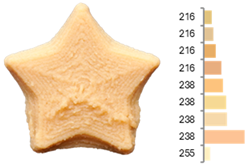 | 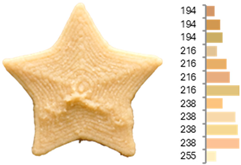 |
| RFB-6 | RFB-7 | RFB-8 | RFB-9 | RFB-10 |
 | 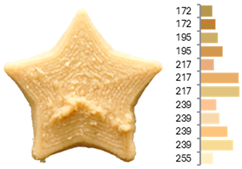 |  | 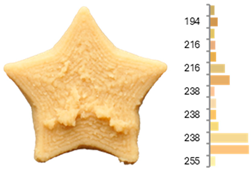 | 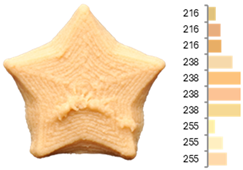 |
| RFB-11 | RFB-12 | RFB-13 | RFB-14 | RFB-15 |
 |  |  |  | 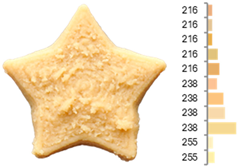 |
| Experiments | Discrepancy Area (mm2) | Total Area (mm2) | Total Perimeter (mm) | Feret Diameter (mm) | Circularity | Round | Solidity | ASM 2 | IDM 3 | Entropy 4 | Firmness (N) | Cohesiveness (g/s) | Elasticity (%) | Brittleness (%) |
|---|---|---|---|---|---|---|---|---|---|---|---|---|---|---|
| RFB-1 | 161.40 d | 2641.40 d | 265.70 b | 72.24 b | 0.47 d | 0.982 c | 0.77 c | 0.21 c | 0.66 ns | 4.799 b | 112.99 e | 171.66 e | 89.16 e | 65.32 e |
| RFB-2 | 51.12 e | 2531.12 e | 249.17 d | 71.34 b | 0.51 c | 0.984 b | 0.75 c | 0.28 a | 0.63 ns | 4.421 c | 155.36 b | 212.70 b | 92.99 d | 67.34 c |
| RFB-3 | 256.99 c | 2736.99 c | 253.64 c | 70.73 b | 0.54 b | 0.978 c | 0.76 c | 0.19 c | 0.64 ns | 5.025 a | 106.78 e | 183.30 c | 90.59 e | 66.24 d |
| RFB-4 | 452.95 b | 2932.95 b | 243.82 e | 71.89 b | 0.62 a | 0.981 c | 0.85 b | 0.16 d | 0.60 ns | 5.227 a | 166.92 a | 227.10 b | 95.09 c | 68.58 b |
| RFB-5 | 71.77 e | 2551.77 e | 257.08 c | 72.33 b | 0.49 d | 0.979 c | 0.74 c | 0.23 b | 0.66 ns | 4.562 c | 166.65 a | 249.65 a | 97.79 a | 71.05 a |
| RFB-6 | 74.99 e | 2554.99 e | 260.85 b | 71.51 b | 0.47 d | 0.985 b | 0.75 c | 0.23 b | 0.64 ns | 4.406 c | 148.12 b | 226.99 b | 94.46 c | 68.38 b |
| RFB-7 | 197.06 d | 2677.06 d | 256.82 c | 71.90 b | 0.51 c | 0.988 a | 0.77 c | 0.18 c | 0.69 ns | 4.587 c | 118.92 d | 192.60 c | 91.58 d | 66.78 c |
| RFB-8 | 41.62 e | 2521.62 e | 248.89 d | 71.29 b | 0.61 a | 0.984 b | 0.76 c | 0.23 b | 0.66 ns | 4.213 d | 155.89 b | 223.31 b | 94.14 c | 68.49 b |
| RFB-9 | 166.12 d | 2646.12 d | 247.77 d | 71.63 b | 0.55 b | 0.979 c | 0.79 c | 0.18 c | 0.63 ns | 4.823 b | 133.38 c | 192.66 c | 91.78 d | 66.81 c |
| RFB-10 | 483.06 b | 2963.06 b | 243.85 e | 71.89 b | 0.63 a | 0.988 a | 0.78 c | 0.19 c | 0.65 ns | 4.678 c | 166.77 a | 239.11 a | 96.22 b | 68.79 b |
| RFB-11 | 143.28 d | 2623.28 d | 247.40 d | 71.39 b | 0.54 b | 0.980 c | 0.86 b | 0.16 d | 0.60 ns | 5.136 a | 168.20 a | 242.38 a | 96.44 b | 69.43 b |
| RFB-12 | 11.79 f | 2491.79 f | 260.57 b | 72.20 b | 0.54 b | 0.980 c | 0.78 c | 0.21 c | 0.66 ns | 4.798 b | 152.67 b | 210.26 b | 93.73 c | 67.86 b |
| RFB-13 | 141.06 d | 2621.06 d | 265.78 b | 72.07 b | 0.46 d | 0.981 c | 0.61 d | 0.12 d | 0.70 ns | 4.148 d | 163.46 a | 223.22 b | 94.62 c | 68.23 b |
| RFB-14 | 722.32 a | 3202.32 a | 322.15 a | 78.26 a | 0.47 d | 0.969 e | 0.77 c | 0.15 d | 0.65 ns | 4.727 b | 134.68 c | 193.47 c | 91.96 d | 66.78 c |
| RFB-15 | 236.20 c | 2716.20 c | 248.30 d | 71.87 b | 0.39 e | 0.975 d | 0.93 a | 0.21 c | 0.65 ns | 4.725 b | 166.56 a | 215.77 b | 94.21 c | 67.93 b |
| Dependent Variables | Regression Model | Lack of Fit (p-Value) | R2 | R2 (Adjusted) |
|---|---|---|---|---|
| Discrepancy area (mm2) | 1491.90 − 934.30 X1 + 5.91 X2 − 0.40 X3 | 0.2241 | 0.82 | 0.69 |
| Round | 1.72 − 2.07 X1 − 0.001 X2 + 0.002 X3 0.002 X1X2 + 1.48 X12 + 0.002 X22 | 0.2849 | 0.79 | 0.18 |
| ASM | 0.10 + 0.122 X1 − 0.001 X2 + 0.0001 X3 | 0.3944 | 0.76 | 0.69 |
| Entropy | 19.09 − 53.36 X1 + 0.17 X2 − 0.003 X3 + 0.091 X1X2 − 0.003 X1X3 − 0.00001 X2X3 + 36.76 X12 − 0.001 X22 + 0.0003 X32 | 0.4273 | 0.80 | 0.43 |
| Firmness (g) | −972.24 + 1171.24 X1 − 9.21 X2 + 0.75 X3 + 18.32 X1X2 − 0.84 X1X3 − 0.002 X2X3 | 0.2682 | 0.78 | 0.66 |
| Cohesiveness (g/s) | 2199.49 − 7213.46 X1 − 6.10 X2 + 0.71 X3 + 14.03 X1X2 − 0.77 X1X3 − 0.004 X2X3 + 5580.40 X12 − 0.05 X22 + 0.0001 X32 | 0.4487 | 0.80 | 0.45 |
| EFB-1 | EFB-2 | EFB-3 | EFB-4 | EFB-5 |
 |  |  |  |  |
| EFB-6 | EFB-7 | EFB-8 | EFB-9 | EFB-10 |
 |  |  | 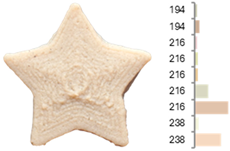 |  |
| EFB-11 | EFB-12 | EFB-13 | EFB-14 | EFB-15 |
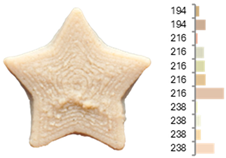 |  |  |  |  |
| Experiments | Discrepancy Area (mm2) | Total Area (mm2) | Total Perimeter (mm) | Feret Diameter (mm) | Circularity | Round | Solidity | ASM 2 | IDM 3 | Entropy 4 | Firmness (N) | Cohesiveness (g/s) | Elasticity (%) | Brittleness (%) |
|---|---|---|---|---|---|---|---|---|---|---|---|---|---|---|
| EFB-1 | 258.37 c | 2738.36 d | 252.74 c | 73.52 ns | 0.54 b | 0.958 e | 0.79 b | 0.20 ns | 0.62 ns | 4.76 b | 270.25 b | 338.46 d | 83.56 d | 62.57 c |
| EFB-2 | 132.72 e | 2812.72 c | 247.12 d | 71.01 ns | 0.58 a | 0.970 d | 0.81 b | 0.18 ns | 0.61 ns | 4.25 d | 220.21 e | 302.03 f | 82.26 e | 61.19 d |
| EFB-3 | 153.31 e | 2633.30 e | 251.08 c | 72.15 ns | 0.53 c | 0.976 c | 0.70 d | 0.23 ns | 0.62 ns | 4.67 c | 292.76 a | 373.69 a | 85.58 a | 64.55 a |
| EFB-4 | 365.58 b | 2545.58 f | 244.957 f | 70.82 ns | 0.53 c | 0.969 d | 0.75 c | 0.22 ns | 0.65 ns | 4.32 d | 203.83 f | 289.67 f | 80.55 f | 59.33 e |
| EFB-5 | 226.71 d | 2706.71 d | 253.73 b | 71.06 ns | 0.53 c | 0.973 d | 0.81 b | 0.20 ns | 0.61 ns | 4.91 a | 258.32 c | 351.34 c | 84.61 b | 63.40 b |
| EFB-6 | 172.10 e | 2652.10 e | 276.39 a | 70.35 ns | 0.44 e | 0.982 a | 0.85 a | 0.20 ns | 0.62 ns | 4.71 b | 205.02 f | 295.33 f | 81.51 f | 60.64 d |
| EFB-7 | 205.51 d | 2885.51 b | 252.03 c | 72.58 ns | 0.57 a | 0.973 d | 0.83 a | 0.17 ns | 0.62 ns | 4.87 b | 244.27 d | 309.16 e | 83.28 d | 62.18 c |
| EFB-8 | 258.95 c | 2738.94 d | 274.88 a | 72.51 ns | 0.46 d | 0.972 d | 0.65 e | 0.21 ns | 0.62 ns | 4.72 b | 206.37 f | 294.97 f | 81.20 f | 60.01 e |
| EFB-9 | 182.73 e | 2662.72 e | 242.98 f | 71.19 ns | 0.57 a | 0.981 a | 0.75 c | 0.20 ns | 0.62 ns | 4.74 b | 264.59 c | 353.27 c | 84.25 c | 63.35 b |
| EFB-10 | 241.65 c | 2721.64 d | 250.34 c | 72.15 ns | 0.52 c | 0.974 d | 0.80 b | 0.22 ns | 0.65 ns | 4.21 e | 271.53 b | 363.60 b | 84.96 b | 63.80 b |
| EFB-11 | 156.45 e | 2636.45 e | 255.47 b | 72.48 ns | 0.53 c | 0.971 d | 0.75 c | 0.21 ns | 0.61 ns | 4.42 c | 273.12 b | 343.12 d | 84.30 c | 63.62 b |
| EFB-12 | 238.18 d | 2718.18 d | 244.66 d | 72.74 ns | 0.53 c | 0.977 b | 0.67 d | 0.21 ns | 0.61 ns | 4.61 c | 247.79 d | 322.57 e | 83.93 d | 63.00 c |
| EFB-13 | 146.60 e | 2626.60 e | 255.06 b | 72.84 ns | 0.51 c | 0.979 b | 0.75 c | 0.22 ns | 0.62 ns | 4.84 a | 208.86 f | 301.20 f | 82.39 e | 61.44 d |
| EFB-14 | 196.71 e | 2676.70 e | 247.60 d | 70.64 ns | 0.55 b | 0.978 b | 0.72 c | 0.20 ns | 0.61 ns | 4.98 a | 225.59 e | 309.84 e | 82.53 e | 61.57 d |
| EFB-15 | 439.45 a | 2919.44 a | 243.89 f | 70.49 ns | 0.58 a | 0.975 c | 0.86 a | 0.19 ns | 0.61 ns | 4.35 d | 275.00 b | 340.63 d | 84.26 c | 63.39 b |
| Dependent Variables | Regression Model | Lack of Fit p-Value | R2 | R2 (Adjusted) |
|---|---|---|---|---|
| Discrepancy area (mm2) | 1213.87 − 673.58 X1 − 11.28 X2 + 0.06 X3 + 12.36 X1X2 + 0.12 X1X3 − 0.01 X2X3 | 0.4211 | 0.77 | 0.42 |
| Perimeter (mm) | −195.27 + 209.83 X1 + 8.32 X2 + 0.05 X3 − 0.23 X1X2 + 0.004 X1X3 − 0.0001 X2X3 − 41.68 X12 − 0.10 X22 − 0.0001 X32 | 0.6175 | 0.86 | 0.61 |
| Circularity | 2.34 − 0.85 X1 − 0.03 X2 − 0.003 X3 +0.0002 X1X2 + 0.15 X12 + 0.0003 X22 | 0.2950 | 0.75 | 0.29 |
| Round | 0.86 + 0.02 X1 + 0.002 X2 + 0.0001 X3 + 0.003 X1X2 | 0.3438 | 0.82 | 0.74 |
| Entropy | 8.32 − 1.15 X1 − 0.05 X2 − 0.002 X3 + 0.016 X1X2 + 0.0001 X1X3 | 0.2487 | 0.73 | 0.44 |
| Firmness (g) | 259.07 − 16.97 X1 + 1.43 X2 − 0.019 X3 | 0.2239 | 0.70 | 0.32 |
| Variables | Criterion | Lower Limit | Upper Limit | Importance | Expected Values |
|---|---|---|---|---|---|
| RFB | |||||
| X1: Water-to-flour ratio | In range | 0.67 | 0.83 | 3 | 0.806 |
| X2: Temperature (°C) | In range | 23.18 | 56.82 | 3 | 23.18 |
| X3: Speed (mm/min) | In range | 1629.5 | 2470.5 | 3 | 2470.5 |
| Discrepancy area (mm2) | Minimize | 11 | 722.3 | 5 | 10.41 |
| Round | Maximize | 1 | 1 | 3 | 0.99 |
| ASM | Maximize | 0.2 | 0.3 | 3 | 0.247 |
| Entropy | Minimize | 4 | 5.2 | 3 | 4.275 |
| Firmness (g) | Maximize | 106.8 | 170 | 3 | 151.503 |
| Cohesiveness (g/s) | Maximize | 170 | 250 | 3 | 256.817 |
| EFB | |||||
| X1: Water-to-flour ratio | In range | 1.66 | 3.34 | 3 | 1.66 |
| X2: Temperature (°C) | In range | 23.18 | 56.82 | 3 | 56.82 |
| X3: Speed (mm/min) | In range | 659 | 2341 | 3 | 1505.43 |
| Discrepancy area (mm2) | Minimize | 65.6 | 439.4 | 5 | 36.20 |
| Perimeter (mm) | Minimize | 242 | 276 | 3 | 222.93 |
| Circularity | Maximize | 0.4 | 0.6 | 3 | 0.631 |
| Round | Maximize | 0.9 | 1 | 3 | 0.977 |
| Entropy | Minimize | 4.3 | 4.9 | 3 | 4.49 |
| Firmness (g) | Maximize | 203.8 | 292.8 | 3 | 277.75 |
Disclaimer/Publisher’s Note: The statements, opinions and data contained in all publications are solely those of the individual author(s) and contributor(s) and not of MDPI and/or the editor(s). MDPI and/or the editor(s) disclaim responsibility for any injury to people or property resulting from any ideas, methods, instructions or products referred to in the content. |
© 2025 by the authors. Licensee MDPI, Basel, Switzerland. This article is an open access article distributed under the terms and conditions of the Creative Commons Attribution (CC BY) license (https://creativecommons.org/licenses/by/4.0/).
Share and Cite
Quispe Santivañez, G.W.; Javier Ninahuaman, H.J.; Paucarchuco Soto, J.; Pedrosa Silva Clerici, M.T.; Salvador-Reyes, R. Optimization of 3D Extrusion Printing Parameters for Raw and Extruded Dehulled Andean Fava Bean Flours Using Response Surface Methodology (RSM). Foods 2025, 14, 715. https://doi.org/10.3390/foods14050715
Quispe Santivañez GW, Javier Ninahuaman HJ, Paucarchuco Soto J, Pedrosa Silva Clerici MT, Salvador-Reyes R. Optimization of 3D Extrusion Printing Parameters for Raw and Extruded Dehulled Andean Fava Bean Flours Using Response Surface Methodology (RSM). Foods. 2025; 14(5):715. https://doi.org/10.3390/foods14050715
Chicago/Turabian StyleQuispe Santivañez, Grimaldo Wilfredo, Henry Juan Javier Ninahuaman, Joselin Paucarchuco Soto, Maria Teresa Pedrosa Silva Clerici, and Rebeca Salvador-Reyes. 2025. "Optimization of 3D Extrusion Printing Parameters for Raw and Extruded Dehulled Andean Fava Bean Flours Using Response Surface Methodology (RSM)" Foods 14, no. 5: 715. https://doi.org/10.3390/foods14050715
APA StyleQuispe Santivañez, G. W., Javier Ninahuaman, H. J., Paucarchuco Soto, J., Pedrosa Silva Clerici, M. T., & Salvador-Reyes, R. (2025). Optimization of 3D Extrusion Printing Parameters for Raw and Extruded Dehulled Andean Fava Bean Flours Using Response Surface Methodology (RSM). Foods, 14(5), 715. https://doi.org/10.3390/foods14050715






